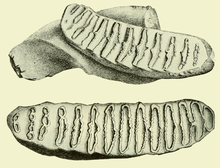| Loxodonta atlantica Temporal range: Late Pliocene to Middle Pleistocene | |
|---|---|

| |
| Scientific classification | |
| Domain: | Eukaryota |
| Kingdom: | Animalia |
| Phylum: | Chordata |
| Class: | Mammalia |
| Order: | Proboscidea |
| Family: | Elephantidae |
| Genus: | Loxodonta |
| Species: | †L. atlantica |
| Binomial name | |
| †Loxodonta atlantica Pomel, 1879 | |
Loxodonta atlantica is an extinct African species of elephant in the genus Loxodonta (which includes living African elephants). It was larger than modern African elephants, with more progressive dentition. It includes Pleistocene fossils from Ternifine, Algeria, Middle Pleistocene fossils from Elandsfontein, South Africa and Late Pliocene fossils from the Omo River, Ethiopia. It is suggested to have an extinction date of around 400,000 years ago, during the Middle Pleistocene. L. atlantica has been suggested to have probably derived from L. adaurora; or L. exoptata. It is likely ancestral to the living African bush elephant, L. africana, with which it coexisted during the Middle Pleistocene prior to its extinction. The species is divided into two subspecies: L. atlantica atlantica (northern Africa) and L. atlantica zulu (southern Africa). The type for Loxodonta atlantica is housed in the Muséum national d'histoire naturelle in Paris, but is listed without a specimen number.
References
- Owen-Smith, R. Norman (1988). Megaherbivores: the influence of very large body size on ecology. Cambridge University Press. ISBN 0-521-36020-X.
- Geraads, D. (1987). "Dating the Northern African cercopithecid fossil record" (PDF). Human Evolution. 2: 19–27. doi:10.1007/BF02436528. S2CID 84223113.
- ^ Carruthers, Jane; et al. (2008). "The Elephant in South Africa: History and Distribution" (PDF). In Scholes, R. J.; Mennell, K. G. (eds.). Elephant management: A Scientific Assessment for South Africa. Wits University Press. pp. 23–83. doi:10.18772/22008034792. ISBN 978-1-86814-479-2. Archived from the original (PDF) on 26 April 2012.
- Stewart, Mathew; Louys, Julien; Price, Gilbert J.; Drake, Nick A.; Groucutt, Huw S.; Petraglia, Michael D. (May 2019). "Middle and Late Pleistocene mammal fossils of Arabia and surrounding regions: Implications for biogeography and hominin dispersals". Quaternary International. 515: 12–29. Bibcode:2019QuInt.515...12S. doi:10.1016/j.quaint.2017.11.052.
- ^ Coppens, Y.; Maglio, V. J.; Madden, C. T.; Beden, M. (1978). "Proboscidea". In Maglio, V. J.; Cooke, H. B. S. (eds.). Evolution of African mammals. Cambridge MA: Harvard University Press. pp. 336–367. ISBN 0-674-27075-4.
- ^ Todd, Nancy E. (2010). "New Phylogenetic Analysis of the Family Elephantidae Based on Cranial-Dental Morphology". The Anatomical Record: Advances in Integrative Anatomy and Evolutionary Biology. 293 (1): 74–90. doi:10.1002/ar.21010. PMID 19937636.
| Extant Proboscidea species by family | |||||
|---|---|---|---|---|---|
| |||||
| Elephantidae (Elephants) |
| ||||
| Category | |||||
| Taxon identifiers | |
|---|---|
| Loxodonta atlantica | |
This article about a prehistoric proboscidean is a stub. You can help Misplaced Pages by expanding it. |